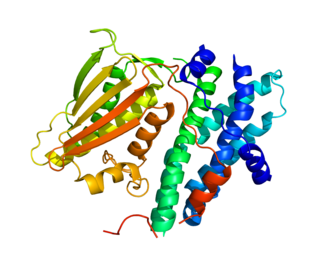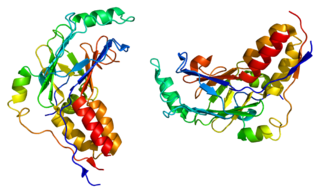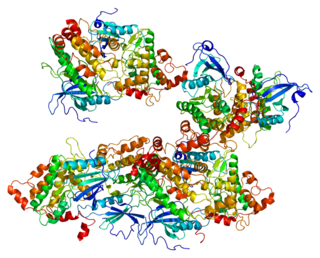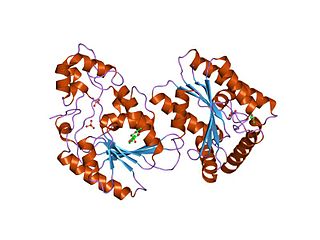| FRGCA | |||||||||||||||||||||||||||||||||||||||||||||||||||
|---|---|---|---|---|---|---|---|---|---|---|---|---|---|---|---|---|---|---|---|---|---|---|---|---|---|---|---|---|---|---|---|---|---|---|---|---|---|---|---|---|---|---|---|---|---|---|---|---|---|---|---|
| Identifiers | |||||||||||||||||||||||||||||||||||||||||||||||||||
| Aliases | FRGCA , FOXM1-regulated, gastric cancer associated | ||||||||||||||||||||||||||||||||||||||||||||||||||
| External IDs | GeneCards: FRGCA | ||||||||||||||||||||||||||||||||||||||||||||||||||
| |||||||||||||||||||||||||||||||||||||||||||||||||||
| |||||||||||||||||||||||||||||||||||||||||||||||||||
| |||||||||||||||||||||||||||||||||||||||||||||||||||
| Wikidata | |||||||||||||||||||||||||||||||||||||||||||||||||||
| |||||||||||||||||||||||||||||||||||||||||||||||||||
FOXM1-regulated, gastric cancer associated is a long non-coding RNA that in humans is encoded by the FRGCA gene. [3]
| FRGCA | |||||||||||||||||||||||||||||||||||||||||||||||||||
|---|---|---|---|---|---|---|---|---|---|---|---|---|---|---|---|---|---|---|---|---|---|---|---|---|---|---|---|---|---|---|---|---|---|---|---|---|---|---|---|---|---|---|---|---|---|---|---|---|---|---|---|
| Identifiers | |||||||||||||||||||||||||||||||||||||||||||||||||||
| Aliases | FRGCA , FOXM1-regulated, gastric cancer associated | ||||||||||||||||||||||||||||||||||||||||||||||||||
| External IDs | GeneCards: FRGCA | ||||||||||||||||||||||||||||||||||||||||||||||||||
| |||||||||||||||||||||||||||||||||||||||||||||||||||
| |||||||||||||||||||||||||||||||||||||||||||||||||||
| |||||||||||||||||||||||||||||||||||||||||||||||||||
| Wikidata | |||||||||||||||||||||||||||||||||||||||||||||||||||
| |||||||||||||||||||||||||||||||||||||||||||||||||||
FOXM1-regulated, gastric cancer associated is a long non-coding RNA that in humans is encoded by the FRGCA gene. [3]

Pyruvate dehydrogenase lipoamide kinase isozyme 1, mitochondrial is an enzyme that in humans is encoded by the PDK1 gene. It codes for an isozyme of pyruvate dehydrogenase kinase (PDK).

Mothers against decapentaplegic homolog 3 also known as SMAD family member 3 or SMAD3 is a protein that in humans is encoded by the SMAD3 gene.

Sialomucin core protein 24 also known as endolyn or CD164 is a protein that in humans is encoded by the CD164 gene. CD164 functions as a cell adhesion molecule.

MYC proto-oncogene, bHLH transcription factor is a protein that in humans is encoded by the MYC gene which is a member of the myc family of transcription factors. The protein contains basic helix-loop-helix (bHLH) structural motif.

Runt-related transcription factor 3 is a protein that in humans is encoded by the RUNX3 gene.

Forkhead box protein M1 is a protein that in humans is encoded by the FOXM1 gene. The protein encoded by this gene is a member of the FOX family of transcription factors. Its potential as a target for future cancer treatments led to it being designated the 2010 Molecule of the Year.

Metastasis-associated protein MTA2 is a protein that in humans is encoded by the MTA2 gene.

Zinc finger homeobox protein 3 is a protein that in humans is encoded by the ZFHX3 gene.

ID4 is a protein coding gene. In humans, it encodes for the protein known as DNA-binding protein inhibitor ID-4. This protein is known to be involved in the regulation of many cellular processes during both prenatal development and tumorigenesis. This is inclusive of embryonic cellular growth, senescence, cellular differentiation, apoptosis, and as an oncogene in angiogenesis.

Protein atonal homolog 1 is a protein that in humans is encoded by the ATOH1 gene.

Glucocorticoid receptor DNA-binding factor 1 is a protein that in humans is encoded by the GRLF1 gene.

Protein odd-skipped-related 1 is a transcription factor that in humans is encoded by the OSR1 gene. The OSR1 and OSR2 transcription factors participate in the normal development of body parts such as the kidney.

Death-associated protein kinase 2 is an enzyme that in humans is encoded by the DAPK2 gene.

Gastrokine-1 is a protein that in humans is encoded by the GKN1 gene.

NADH dehydrogenase [ubiquinone] 1 alpha subcomplex subunit 10 is an enzyme that in humans is encoded by the NDUFA10 gene. The NDUFA10 protein is a subunit of NADH dehydrogenase (ubiquinone), which is located in the mitochondrial inner membrane and is the largest of the five complexes of the electron transport chain. Mutations in subunits of NADH dehydrogenase (ubiquinone), also known as Complex I, frequently lead to complex neurodegenerative diseases such as Leigh's syndrome. Furthermore, reduced NDUFA10 expression levels due to FOXM1-directed hypermethylation are associated with human squamous cell carcinoma and may be related to other forms of cancer.

Transmembrane 4 L6 family member 5 is a protein that in humans is encoded by the TM4SF5 gene.

Calpain-9 is a protein that in humans is encoded by the CAPN9 gene.

6-phosphofructo-2-kinase/fructose-2,6-biphosphatase 4 also known as PFKFB4 is an enzyme which in humans is encoded by the PFKFB4 gene.

MicroRNA 4521 is a micro RNA that in humans is encoded by the MIR4521 gene.

CDK2 associated cullin domain 1 is a protein that in humans is encoded by the CACUL1 gene.